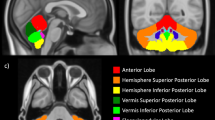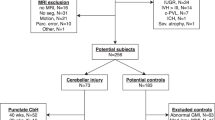Abstract
Objective:
The aim of this study was to assess cerebellar growth of very low birth weight infants from birth to discharge and compare it with term infants.
Study Design:
Very low birth weight infants were matched by gender, adequacy of weight to gestational age at birth and postmenstrual ages at hospital discharge to term newborns. Exclusion criteria were central nervous system malformation, peri-intraventricular hemorrhage, cerebellar hemorrhage and meningitis. Transverse cerebellar diameter was measured by cranial ultrasound at birth and at hospital discharge in cases, and at birth in matched controls. Very low birth weight infants had magnetic resonance imaging done in the first year.
Result:
Cerebellar growth was similar in very low birth weight infants without periventricular leukomalacia and controls, and smaller in cases with periventricular leukomalacia than in controls.
Conclusion:
We suggest that cerebellar growth is normal in the absence of supratentorial injury.
This is a preview of subscription content, access via your institution
Access options
Subscribe to this journal
Receive 12 print issues and online access
$259.00 per year
only $21.58 per issue
Buy this article
- Purchase on Springer Link
- Instant access to full article PDF
Prices may be subject to local taxes which are calculated during checkout
Similar content being viewed by others
References
Marlow N, Roberts BL, Cooke RW . Motor skills in extremely low birthweight children at age of 6 years. Arch Dis Child 1989; 64 (6): 839–847.
Hadders-Algra M, Huisjes HJ, Towen BC . Perinatal risk factors and minor neurological dysfunction: significance for behavior and school achievement at nine years. Dev Ment Child Neurol 1988; 30 (4): 482–491.
Hadders-Algra M, Huisjes HJ, Towen BC . Perinatal correlates of major and minor neurological dysfunction at school age: a multivariate analysis. Dev Ment Child Neurol 1988; 30 (4): 472–481.
Schmahmann JD, Sherman JC . The cerebellar cognitive affective syndrome. Brain 1998; 121 (Part 4): 561–579.
Diamond A . Close interrelation of motor development and cognitive development and of cerebellum and prefrontal cortex. Child Dev 2000; 71 (1): 44–56.
Allin M, Matsumoto H, Santhouse AM, Nosarti C, AlAsady MH, Stewart AL et al. Cognitive and motor function and the size of the cerebellum in adolescents born very pre-term. Brain 2001; 124 (Part 1): 60–66.
Chang CH, Chang FM, Yu CH, Ko HC, Chen HY . Assessment of fetal cerebellar volume using three-dimensional ultrasound. Ultrasound Med Biol 2000; 26 (6): 981–988.
Peterson BS, Vohr B, Staib LH, Cannistraci CJ, Dolberg A, Schneider KC et al. Regional brain volume abnormalities and long-term cognitive outcome in preterm infants. JAMA 2000; 284 (15): 1939–1947.
Parker J, Mitchell A, Kalpakidou A, Walshe M, Jung HY, Nosarti C et al. Cerebellar growth and behavioural & neuropsychological outcome in preterm adolescents. Brain 2008; 131 (Part 5): 1344–1351.
Limperopoulos C, Soul JS, Gauvreau K, Huppi PS, Warfield SK, Bassan H et al. Late gestation cerebellar growth is rapid and impeded by premature birth. Pediatrics 2005; 115 (3): 688–695.
Shah DK, Anderson PJ, Carlin JB, Pavlovic M, Howard K, Thompson DK et al. Reduction in cerebellar volumes in preterm infants: relationship to white matter injury and neurodevelopment at two years of age. Pediatr Res 2006; 60 (1): 97–102.
Alexander GR, Himes JH, Kaufman RB, Mor J, Kogan M . A United Sates national reference for fetal growth. Obstet Gynecol 1996; 87 (2): 163–168.
Report of the National High Blood Pressure Education Program Working Group on High Blood Pressure in Pregnancy. Am J Obstet Gynecol 2000; 183 (1): S1–S22.
Spittle AJ, Doyle LW, Anderson PJ, Inder TE, Lee KJ, Boyd RN et al. Reduced cerebellar diameter in very preterm infants with abnormal general movements. Early Hum Dev 2010; 86 (1): 1–5.
Srinivasan L, Allsop J, Counsell SJ, Boardman JP, Edwards AD, Rutherford M . Smaller cerebellar volumes in very preterm infants at term-equivalent age are associated with the presence of supratentorial lesions. AJNR 2006; 27 (3): 573–579.
Volpe JJ . Cerebellum of the premature infant: rapidly developing, vulnerable, clinically important. J Child Neurol 2009; 24 (9): 1085–1104.
Tam EW, Miller SP, Studholme C, Chau V, Glidden D, Poskitt KJ et al. Differential effects of intraventricular hemorrhage and white matter injury on preterm cerebellar growth. J Pediatr 2011; 158 (3): 366–371.
Acknowledgements
We thank Vania Hirakata for statistical analysis and Isaura Reidl for English revision.
Author information
Authors and Affiliations
Corresponding author
Ethics declarations
Competing interests
The authors declare no conflict of interest.
Rights and permissions
About this article
Cite this article
Jaeger, E., Silveira, R. & Procianoy, R. Cerebellar growth in very low birth weight infants. J Perinatol 31, 757–759 (2011). https://doi.org/10.1038/jp.2011.20
Received:
Revised:
Accepted:
Published:
Issue Date:
DOI: https://doi.org/10.1038/jp.2011.20
Keywords
This article is cited by
-
Mental health and cerebellar volume during adolescence in very-low-birth-weight infants: a longitudinal study
Child and Adolescent Psychiatry and Mental Health (2016)
-
Late Preterm Birth: A Review of Medical and Neuropsychological Childhood Outcomes
Neuropsychology Review (2012)



